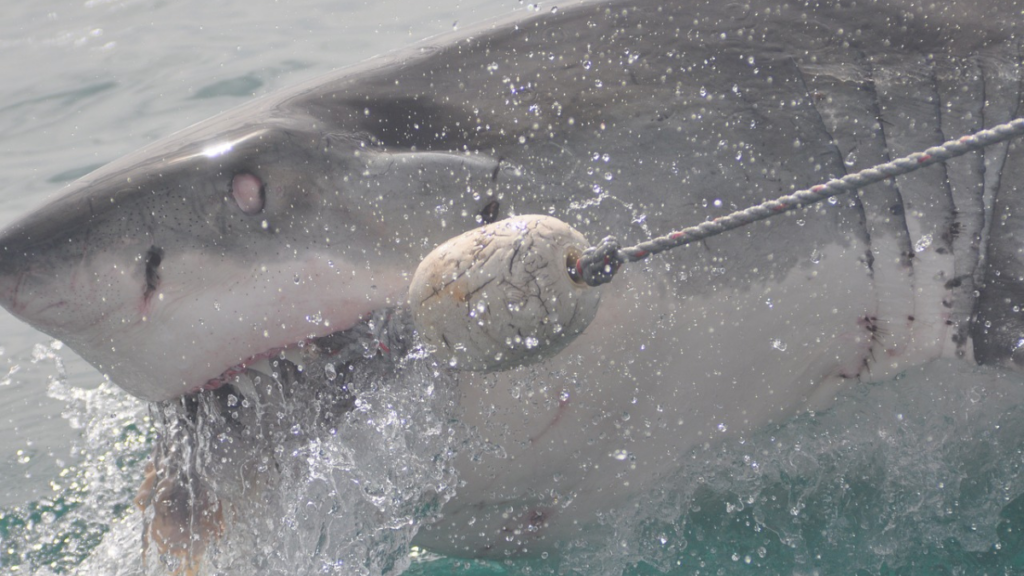Deep Blue is – after the animatronic star of Spielberg’s seminal 1975 summer blockbuster, Jaws – probably the most famous great white shark in the world.
She is famous the world over not only for her prodigious size but also for the extreme docility that belies the reputation of great whites as bloodthirsty killers.
As the subject of intense curiosity, the Deep Blue shark has been pretty widely studied – and a number of crazy facts uncovered about the gargantuan great white.
Read on for the 7 craziest facts about Deep Blue…
She May Be The Biggest Great White Shark In The World
It’s tough to get accurate measurements on live sharks by virtue of the fact that they’re constantly in motion and not exactly inclined (or able) to sit still while someone gets a tape measure out.
That means that verifiable measurements always come from dead sharks rather than live ones.
The largest verified great white shark ever was a female that measured 19.1ft (5.83m). Bear in mind that this sort of size in itself is unusual – most female great whites max out at around 15-16ft (4.6-4.9m).
Which is why Deep Blue’s size is so remarkable. Though it is, as mentioned, not possible to accurately measure her length, it’s estimated that she sits somewhere around the 20ft (6.1m) mark – making her comfortably the largest great white shark ever encountered.
She’s Believed To Be Over 50 Years Old
Marine biologists can accurately measure the age of a shark – if it’s already dead. This is done by examining its skeleton – and its vertebrae in particular – to calculate the shark’s age.
Obviously, that’s not possible with live sharks, which means that a little guesswork is necessary when it comes to an aging one that’s still on the move. But since great whites never stop growing, it is possible to estimate their age from their size.
Most estimates put Deep Blue at over 50 years old – meaning that she first swam the waters of the Pacific sometime in the 1970s.
She Was First Spotted Off Guadalupe Island
The Mexican island of Guadalupe is a place that’s famous for its large great white population. The sharks are often spotted in the waters off the island, to the point where it’s an extremely popular tourist destination for those wishing to cage-dive with the notorious creatures.
It was also here where Deep Blue was first spotted by a shark researcher named Mauricio Hoyas Padilla. Padilla, who was coincidentally filming a documentary with Discovery as part of Shark Week, posted a video to Facebook that immediately went viral. She was also included in the Discovery documentary that he was helping to film.
She Was Later Spotted In Hawaii
Hawaii is well known for the preponderance of sharks in its waters, but most of those sharks tend to be tigers rather than great whites.
The reason for this is simple: great whites prefer cooler waters to those found around Hawaii, and so are occasional visitors to the Pacific archipelago rather than permanent residents.
It was something of a surprise, then, when controversial shark conservationist Ocean Ramsey purportedly encountered Deep Blue in February 2019.
Ramsey and her team were in the area to document tiger sharks feeding on a whale carcass when the famous shark herself appeared from the depths.
Ramsey generated a lot of controversy at the time; she swam alongside and touched the shark, as well as holding onto her fin in order to be pulled alongside her.
Many decried this as irresponsible behavior, with calls for Ramsey to refrain from interfering with marine wildlife in such a way.
Some also claimed that the shark Ramsey swam with wasn’t Deep Blue at all but another large female nicknamed Haole Girl.
Her Preferred Food Is Different To That Of Many Great Whites

It’s no surprise that Deep Blue was allegedly spotted near the carcass of a whale near Hawaii in 2019 – the huge cetaceans are the preferred food of larger females by far, with the hugest great whites often being spotted feasting on the blubbery carcasses.
This is, in contrast, of course, to the prey of choice for smaller great whites. The fearsome fish famously have a taste for seals and sea lions, and many of the more famous sightings come from the acrobatic ‘breaches’ that great whites do when they ambush a seal from below.
So why do the larger great whites refrain from the traditionally preferred prey of their species? Simply put: because they’re over the hill.
The older a great white gets, the bigger it gets. And with this increased bulk comes reduced mobility – and an inability to chase or catch more nimble prey like seals and sea turtles.
Instead, then, older sharks go for the very easy prey that is a dead whale. The whale isn’t going anywhere, after all, and is a great source of high-fat food for big sharks.
She’s Extremely Docile
Great whites are typically not aggressive to humans, treating them more as a curiosity than anything else.
That said, it’s still not advisable to get too close to one – it may perceive anything coming too close as a threat and respond accordingly.
However, Deep Blue is extremely docile, and has been shown to be non-aggressive to humans and even dolphins.
This much was demonstrated by Ocean Ramsey, who was able to swim in close proximity to (and even touch) the shark without provoking any response at all.
Mauricio Hoyas Padilla was, similarly, able to be outside the cage environment near her (and touch her fin) with no aggressive response at all.
She May Have Been Pregnant In Hawaii
In addition to her striking length, Deep Blue was also noted for her incredible girth – even by the standards of great whites.
The footage taken by Ocean Ramsey and her team reveals the staggering scale of the shark. Many experts have concluded that Deep Blue was likely pregnant at the time.
The Deep Blue Shark is One of the Biggest Great Whites Ever Caught on Film!
We hope that this article has opened your eyes regarding the largest and most impressive great white shark ever documented on film.
As time goes by, there are sure to be more and more crazy facts revealed about Deep Blue and other sharks like her!
